Suppressed Expression of Allergenic Transcripts in Different Tomato Cultivars Are Linked with Increased Antioxidant Capacity
Abstract
1. Introduction
2. Results
2.1. Measurements of Titratable Acidity (TA)
2.2. Examination of Lycopene and β-Carotene Content
2.3. Antioxidant Capacity of Tomatoes
2.4. Allergen Content by Immunoassay Analysis
2.5. Allergenic Gene Expression Profiles of Different Tomato Cultivars
2.6. Correlation Between Antioxidant Components and Allergens
3. Discussion
3.1. Comparison of Fruit Quality
3.2. Antioxidant Activity
3.3. Analysis of Allergen Content
3.4. Correlation Between Antioxindants Activity and Allergens Conten
4. Materials and Methods
4.1. Plant Material
4.2. Titratable Acidity (TA)
4.3. Lycopene and β-Carotene Content
4.4. Antioxidant Capacity
4.5. Profilin and Bet v 1 ELISA Analysis
4.6. RNA Extraction
4.7. cDNA Synthesis and Quantitative Real-Time RT-qPCR Analysis
4.8. Statistical Analysis
5. Conclusions
Supplementary Materials
Author Contributions
Funding
Data Availability Statement
Conflicts of Interest
Abbreviations
| RT-qPCR | quantitative real-time polymerase chain reaction |
| qPCR | real-time polymerase chain reaction |
| FRAP assay | Ferric Reducing Antioxidant Power assay |
| ABTS assay | 2,2’-azino-bis-(3-ethylbenzothiazoline-6-sulfonic) acid assay |
| Sol l1 | profilin |
| Sol l 2 | b-fructofuranosidase |
| Sol l 3 | lipid transfer protein |
| Sol l4 | intracellular pathogenesis-related protein |
| Sol l 5 | cyclophilin |
| Sol l 6 | 7 kDa lipid transfer protein |
| Sol l 7 | 11 kDa lipid transfer protein |
| ELISA | Enzyme-Linked Immunosorbent Assay |
| TA | titratable acidity |
| RG | Russian Gold |
| BG | Black Plum |
| PAS | Paschalne |
| CH. | Cherry F1 |
| COM | Commodo F1 |
| TOR | Torry F1 |
References
- Ring, J.; Behrendt, H. Allergy and Civilization. In Strategies for Sustainability of the Earth System; Wilderer, P.A., Grambow, M., Molls, M., Oexle, K., Eds.; Springer International Publishing: Cham, Switzerland, 2022; pp. 283–293. ISBN 978-3-030-74458-8. [Google Scholar]
- Kopp, W. How Western Diet And Lifestyle Drive The Pandemic Of Obesity And Civilization Diseases. Diabetes Metab. Syndr. Obes. 2019, 12, 2221–2236. [Google Scholar] [CrossRef]
- Gulli, M.; Graziano, S.; Marmiroli, N. Detection of Allergen Coding Sequences of Kiwi, Peach, and Apple in Processed Food by QPCR. J. Sci. Food Agric. 2017, 98, 3129–3139. [Google Scholar] [CrossRef]
- Panel, N.-S.E.; A Boyce, J.; Assa’Ad, A.; Burks, A.W.; Jones, S.M.; A Sampson, H.; A Wood, R.; Plaut, M.; Cooper, S.F.; Fenton, M.J.; et al. Guidelines for the Diagnosis and Management of Food Allergy in the United States: Report of the NIAID-Sponsored Expert Panel. J. Allergy Clin. Immunol. 2010, 126, S1–S58. [Google Scholar] [CrossRef]
- De Martinis, M.; Sirufo, M.M.; Suppa, M.; Ginaldi, L. New Perspectives in Food Allergy. Int. J. Mol. Sci. 2020, 21, 1474. [Google Scholar] [CrossRef]
- Sicherer, S.H.; Sampson, H.A. Food Allergy: Epidemiology, Pathogenesis, Diagnosis, and Treatment. J. Allergy Clin. Immunol. 2014, 133, 291–307; quiz 308. [Google Scholar] [CrossRef]
- Li, N.; Wu, X.; Zhuang, W.; Xia, L.; Chen, Y.; Wu, C.; Rao, Z.; Du, L.; Zhao, R.; Yi, M.; et al. Tomato and Lycopene and Multiple Health Outcomes: Umbrella Review. Food Chem. 2021, 343, 128396. [Google Scholar] [CrossRef]
- Cammareri, M.; Frary, A.; Frary, A.; Grandillo, S. Genetic and Biotechnological Approaches to Improve Fruit Bioactive Content: A Focus on Eggplant and Tomato Anthocyanins. Int. J. Mol. Sci. 2024, 25, 6811. [Google Scholar] [CrossRef] [PubMed]
- Wang, C.; Li, M.; Duan, X.; Abu-Izneid, T.; Rauf, A.; Khan, Z.; Mitra, S.; Emran, T.B.; Aljohani, A.S.M.; Alhumaydhi, F.A.; et al. Phytochemical and Nutritional Profiling of Tomatoes; Impact of Processing on Bioavailability—A Comprehensive Review. Food Rev. Int. 2023, 39, 5986–6010. [Google Scholar] [CrossRef]
- Burney, P.G.J.; Potts, J.; Kummeling, I.; Mills, E.N.C.; Clausen, M.; Dubakiene, R.; Barreales, L.; Fernandez-Perez, C.; Fernandez-Rivas, M.; Le, T.-M.; et al. The Prevalence and Distribution of Food Sensitization in European Adults. Allergy 2014, 69, 365–371. [Google Scholar] [CrossRef] [PubMed]
- López-Matas, M.A.; Larramendi, C.H.; Huertas, A.J.; Ferrer, A.; Moya, R.; Pagán, J.A.; Navarro, L.A.; García-Abujeta, J.L.; Carnés, J. Tomato NsLTP as an ‘In Vivo’ Diagnostic Tool: Sensitization in a Mediterranean Population. J. Investig. Allergol. Clin. Immunol. 2015, 25, 196–204. [Google Scholar] [PubMed]
- Asero, R.; Antonicelli, L.; Arena, A.; Bommarito, L.; Colombo, G.; Crivellaro, M.; De Carli, M.; Della-Torre, E.; Della Torre, F.; Heffler, E.; et al. Causes of Food-Induced Anaphylaxis in Italian Adults: A Multi-Centre Study. Int. Arch. Allergy Immunol. 2009, 150, 271–277. [Google Scholar] [CrossRef]
- Roccotiello, E.; Nicosia, E.; Pierdonà, L.; Marescotti, P.; Ciardiello, M.A.; Giangrieco, I.; Mari, A.; Zennaro, D.; Dozza, D.; Brancucci, M.; et al. Tomato (Solanum lycopersicum L.) Accumulation and Allergenicity in Response to Nickel Stress. Sci. Rep. 2022, 12, 5432. [Google Scholar] [CrossRef]
- Worm, M.; Edenharter, G.; Ruëff, F.; Scherer, K.; Pföhler, C.; Mahler, V.; Treudler, R.; Lang, R.; Nemat, K.; Koehli, A.; et al. Symptom Profile and Risk Factors of Anaphylaxis in Central Europe. Allergy 2012, 67, 691–698. [Google Scholar] [CrossRef] [PubMed]
- Ghiani, A.; D’Agostino, N.; Citterio, S.; Raiola, A.; Asero, R.; Barone, A.; Rigano, M.M. Impact of Wild Loci on the Allergenic Potential of Cultivated Tomato Fruits. PLoS ONE 2016, 11, e0155803. [Google Scholar] [CrossRef]
- Welter, S.; Lehmann, K.; Dölle, S.; Schwarz, D.; Weckwerth, W.; Scheler, C.; Worm, M.; Franken, P. Identification of putative new tomato allergens and differential interaction with IgEs of tomato allergic subjects. Clin. Exp. Allergy 2013, 43, 1419–1427. [Google Scholar] [CrossRef] [PubMed]
- D’Agostino, N.; Buonanno, M.; Ayoub, J.; Barone, A.; Monti, S.M.; Rigano, M.M. Identification of non-specific Lipid Transfer Protein gene family members in Solanum lycopersicum and insights into the features of Sola l 3 protein. Sci. Rep. 2019, 9, 1607. [Google Scholar] [CrossRef]
- López-Matas, M.Á.; Larramendi, C.H.; Ferrer, Á.; Huertas, Á.J.; Pagán, J.A.; García-Abujeta, J.L.; Bartra, J.; Andreu, C.; Lavín, J.R.; Carnés, J. Identification and quantification of tomato allergens: In vitro characterization of six dif-ferent varieties. Ann. Allergy Asthma Immunol. 2011, 106, 230–238. [Google Scholar] [CrossRef] [PubMed]
- Kiyota, K.; Yoshimitsu, M.; Satsuki-Murakami, T.; Akutsu, K.; Kajimura, K.; Yamano, T. Detection of the tomato aller-gen Sola l 1 and evaluation of its reactivity after heat and papain treatment. Food Agric. Immunol. 2017, 28, 1450–1459. [Google Scholar] [CrossRef]
- Jamakhani, M.; Lele, S.S.; Rekadwad, B. In silico assessment data of allergenicity and cross-reactivity of NP24 epitopes from Solanum lycopersicum (Tomato) fruit. DIB 2018, 21, 660–674. [Google Scholar] [CrossRef]
- Holzhauser, T.; Johnson, P.; Hindley, J.P.; O’Connor, G.; Chan, C.-H.; Costa, J.; Fæste, C.K.; Hirst, B.J.; Lambertini, F.; Miani, M.; et al. Are Current Analytical Methods Suitable to Verify VITAL® 2.0/3.0 Allergen Reference Doses for EU Allergens in Foods? Food Chem. Toxicol. 2020, 145, 111709. [Google Scholar] [CrossRef]
- Słowianek, M.; Majak, I. Methods of Allergen Detection Based on DNA Analysis. Biotechnol. Food Sci. 2011, 76, 39–44. [Google Scholar] [CrossRef]
- Prado, M.; Ortea, I.; Vial, S.; Rivas, J.; Calo-Mata, P.; Barros-Velázquez, J. Advanced DNA- and Protein-Based Methods for the Detection and Investigation of Food Allergens. Crit. Rev. Food Sci. Nutr. 2016, 56, 2511–2542. [Google Scholar] [CrossRef] [PubMed]
- Watanabe, S.; Taguchi, H.; Temmei, Y.; Hirao, T.; Akiyama, H.; Sakai, S.; Adachi, R.; Urisu, A.; Teshima, R. Specific Detection of Potentially Allergenic Peach and Apple in Foods Using Polymerase Chain Reaction. J. Agric. Food Chem. 2012, 60, 2108–2115. [Google Scholar] [CrossRef] [PubMed]
- Linacero, R.; Sanchiz, A.; Ballesteros, I.; Cuadrado, C. Application of Real-Time PCR for Tree Nut Allergen Detection in Processed Foods. Crit. Rev. Food Sci. Nutr. 2020, 60, 1077–1093. [Google Scholar] [CrossRef]
- Köppel, R.; Dvorak, V.; Zimmerli, F.; Breitenmoser, A.; Eugster, A.; Waiblinger, H.-U. Two Tetraplex Real-Time PCR for the Detection and Quantification of DNA from Eight Allergens in Food. Eur. Food Res. Technol. 2009, 230, 367. [Google Scholar] [CrossRef]
- Suh, S.-M.; Park, S.-B.; Kim, M.-J.; Kim, H.-Y. Simultaneous Detection of Fruit Allergen-Coding Genes in Tomato, Apple, Peach and Kiwi through Multiplex PCR. Food Sci. Biotechnol. 2019, 28, 1593–1598. [Google Scholar] [CrossRef]
- Farinon, B.; Felli, M.; Sulli, M.; Diretto, G.; Savatin, D.V.; Mazzucato, A.; Merendino, N.; Costantini, L. Tomato Pomace Food Waste from Different Variants as a High Antioxidant Potential Resource. Food Chem. 2024, 452, 139509. [Google Scholar] [CrossRef]
- Włodarczyk, K.; Smolińska, B.; Majak, I. The Characterization of the Selected Allergens and Antioxidants of Tomato (Solanum lycopersicum)—A Review. Antioxidants 2022, 11, 644. [Google Scholar] [CrossRef]
- Prasad, K.; Jacob, S.; Siddiqui, M.W. Chapter 2—Fruit Maturity, Harvesting, and Quality Standards. In Preharvest Modulation of Postharvest Fruit and Vegetable Quality; Fallik, E., Ilic, Z., Siddiqui, M.W., Eds.; Academic Press: Cambridge, MA, USA, 2018; pp. 41–69. ISBN 978-0-12-809807-3. [Google Scholar]
- Juroszek, P.; Lumpkin, H.M.; Yang, R.-Y.; Ledesma, D.R.; Ma, C.-H. Fruit Quality and Bioactive Compounds with Antioxidant Activity of Tomatoes Grown On-Farm: Comparison of Organic and Conventional Management Systems. J. Agric. Food Chem. 2009, 57, 1188–1194. [Google Scholar] [CrossRef]
- Tilahun, S.; Seo, M.H.; Park, D.S.; Jeong, C.S. Effect of Cultivar and Growing Medium on the Fruit Quality Attributes and Antioxidant Properties of Tomato (Solanum lycopersicum L.). Hortic. Environ. Biotechnol. 2018, 59, 215–223. [Google Scholar] [CrossRef]
- Dumas, Y.; Dadomo, M.; Lucca, G.; Grolier, P. Review of the Influence of Major Environmental and Agronomic Factors on the Lycopene Content of Tomato Fruit. Acta Hortic. 2002, 579, 595–601. [Google Scholar] [CrossRef]
- Dumas, Y.; Dadomo, M.; Di Lucca, G.; Grolier, P. Effects of Environmental Factors and Agricultural Techniques on Antioxidantcontent of Tomatoes. J. Sci. Food Agric. 2003, 83, 369–382. [Google Scholar] [CrossRef]
- Asero, R.; Mistrello, G.; Roncarolo, D.; Amato, S.; Caldironi, G.; Barocci, F.; Ree, R. Immunological Cross-Reactivity between Lipid Transfer Proteins from Botanically Unrelated Plant-Derived Foods: A Clinical Study. Allergy 2002, 57, 900–906. [Google Scholar] [CrossRef]
- Kitagawa, M.; Moriyama, T.; Ito, H.; Ozasa, S.; Adachi, A.; Yasuda, J.; Ookura, T.; Inakuma, T.; Kasumi, T.; Ishiguro, Y.; et al. Reduction of Allergenic Proteins by the Effect of the Ripening Inhibitor (Rin) Mutant Gene in an F 1 Hybrid of the Rin Mutant Tomato. Biosci. Biotechnol. Biochem. 2006, 70, 1227–1233. [Google Scholar] [CrossRef]
- Hjernoe, K.; Alm, R.; Canbäck, B.; Matthiesen, R.; Trajkovski, K.; Bjork, L.; Roepstorff, P.; Emanuelsson, C. Down-Regulation of the Strawberry Bet v 1-Homologous Allergen in Concert with the Flavonoid Biosynthesis Pathway in Colorless Strawberry Mutant. Proteomics 2006, 6, 1574–1587. [Google Scholar] [CrossRef]
- Mogensen, J.E.; Wimmer, R.; Larsen, J.N.; Spangfort, M.D.; Otzen, D.E. The Major Birch Allergen, Bet v 1, Shows Affinity for a Broad Spectrum of Physiological Ligands. J. Biol. Chem. 2002, 277, 23684–23692. [Google Scholar] [CrossRef]
- Handschuh, L.; Femiak, I.; Kasperska, A.; Figlerowicz, M.; Sikorski, M. Structural and Functional Characteristics of Two Novel Members of Pathogensis-Related Multigene Family of Class 10 from Yellow Lupine+. Acta Biochim. Pol. 2007, 54, 783–796. [Google Scholar] [CrossRef] [PubMed]
- Georgiadou, E.C.; Antoniou, C.; Majak, I.; Goulas, V.; Filippou, P.; Smolińska, B.; Leszczyńska, J.; Fotopoulos, V. Tissue-Specific Elucidation of Lycopene Metabolism in Commercial Tomato Fruit Cultivars during Ripening. Sci. Hortic. 2021, 284, 110144. [Google Scholar] [CrossRef]
- Nagata, M.; Yamashita, I. Simple Method for Simultaneous Determination of Chlorophyll and Carotenoids in Tomato Fruit. Nippon Shokuhin Kogyo Gakkaishi 1992, 39, 925–928. [Google Scholar] [CrossRef]
- Hallmann, E.; Rozpara, E.; Słowianek, M.; Leszczyńska, J. The Effect of Organic and Conventional Farm Management on the Allergenic Potency and Bioactive Compounds Status of Apricots (Prunus armeniaca L.). Food Chem. 2019, 279, 171–178. [Google Scholar] [CrossRef] [PubMed]
- Gambino, G.; Perrone, I.; Gribaudo, I. A Rapid and Effective Method for RNA Extraction from Different Tissues of Grapevine and Other Woody Plants. Phytochem. Anal. 2008, 19, 520–525. [Google Scholar] [CrossRef] [PubMed]
- Georgiadou, E.C.; Goulas, V.; Ntourou, T.; Manganaris, G.A.; Kalaitzis, P.; Fotopoulos, V. Regulation of On-Tree Vitamin E Biosynthesis in Olive Fruit during Successive Growing Years: The Impact of Fruit Development and Environmental Cues. Front. Plant Sci. 2016, 7, 1656. [Google Scholar] [CrossRef]
- Løvdal, T.; Lillo, C. Reference Gene Selection for Quantitative Real-Time PCR Normalization in Tomato Subjected to Nitrogen, Cold, and Light Stress. Anal. Biochem. 2009, 387, 238–242. [Google Scholar] [CrossRef] [PubMed]
- Pfaffl, M.W.; Horgan, G.W.; Dempfle, L. Relative Expression Software Tool (REST) for Group-Wise Comparison and Statistical Analysis of Relative Expression Results in Real-Time PCR. Nucleic Acids Res. 2002, 30, e36. [Google Scholar] [CrossRef] [PubMed]

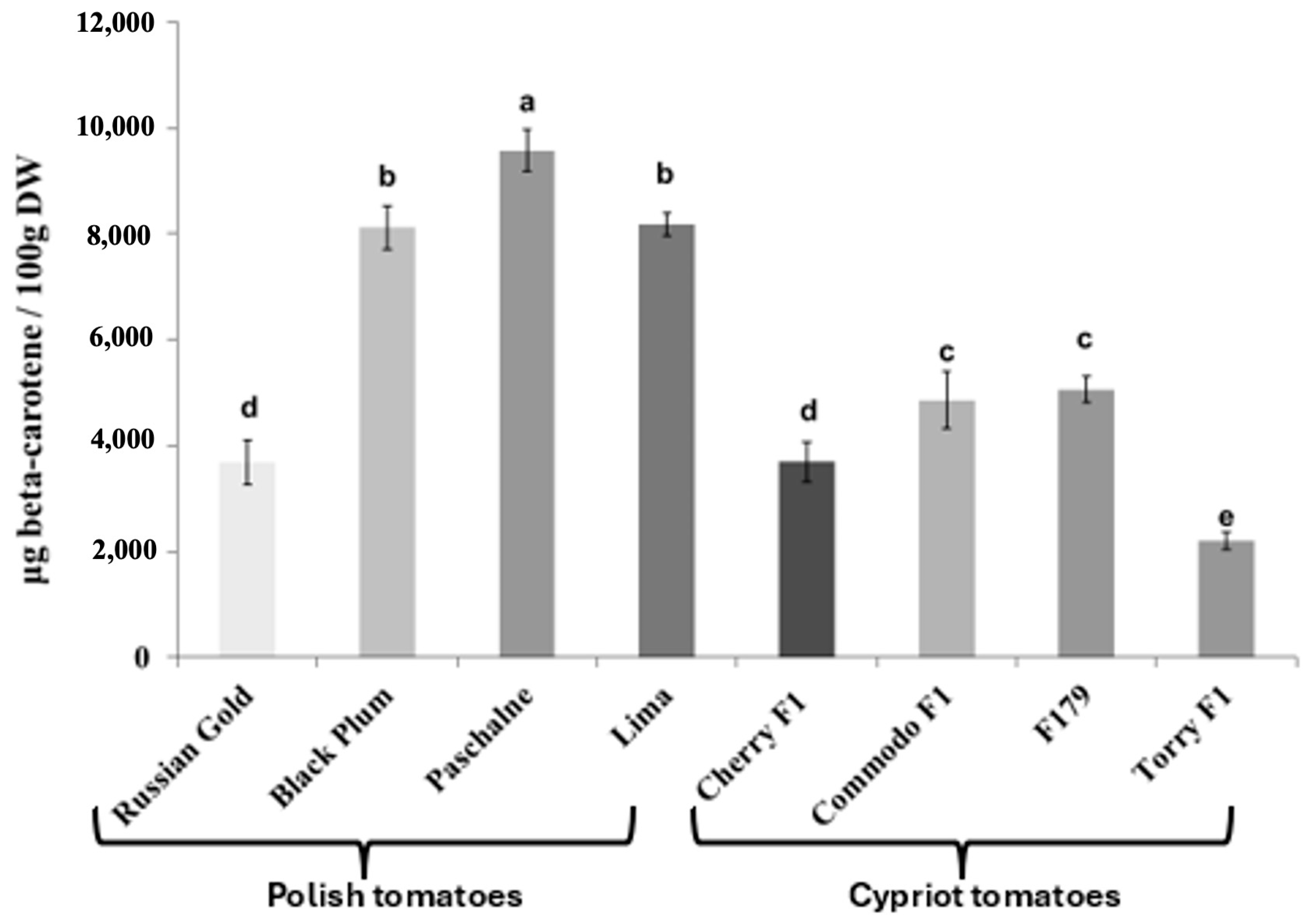
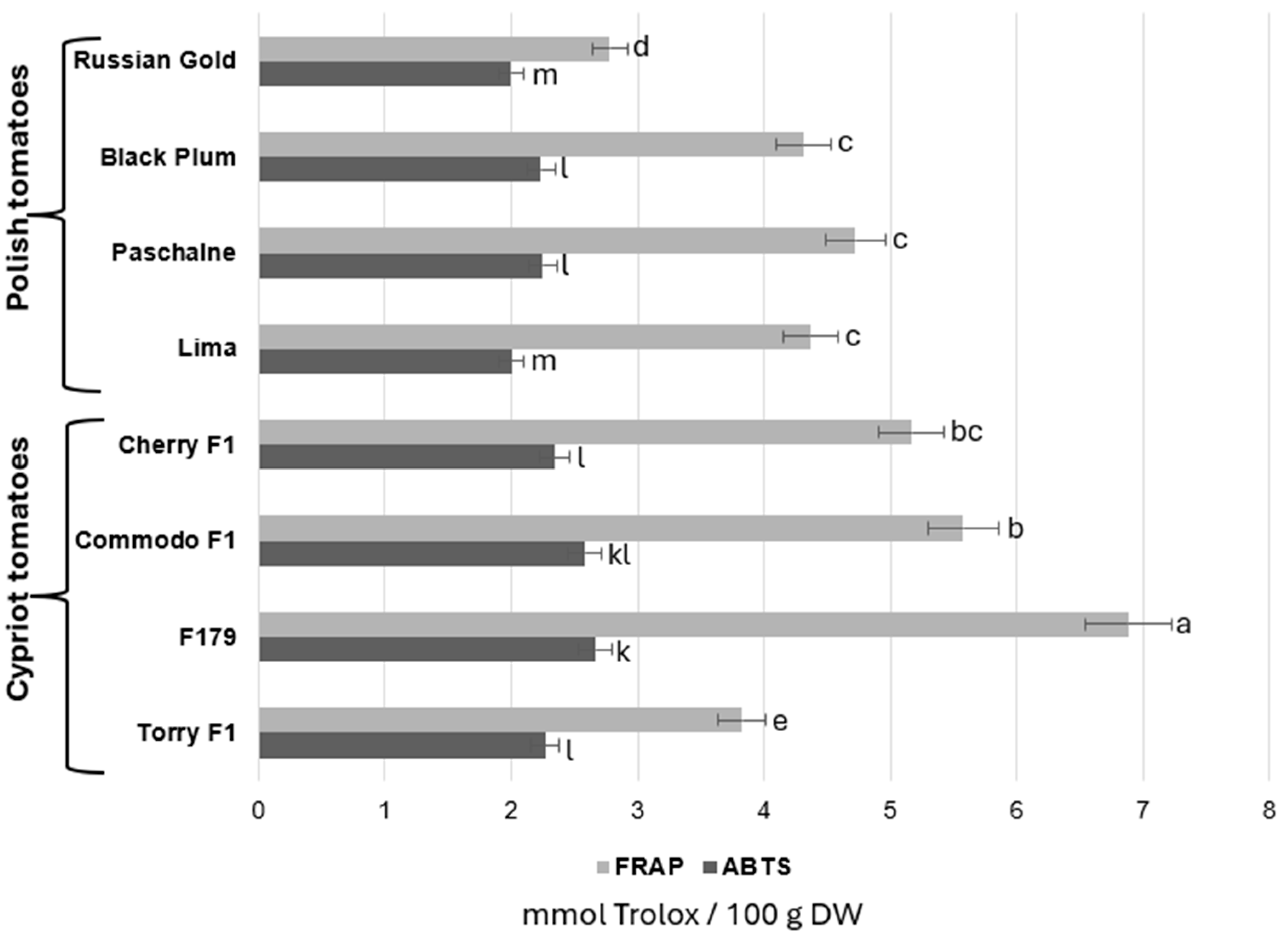
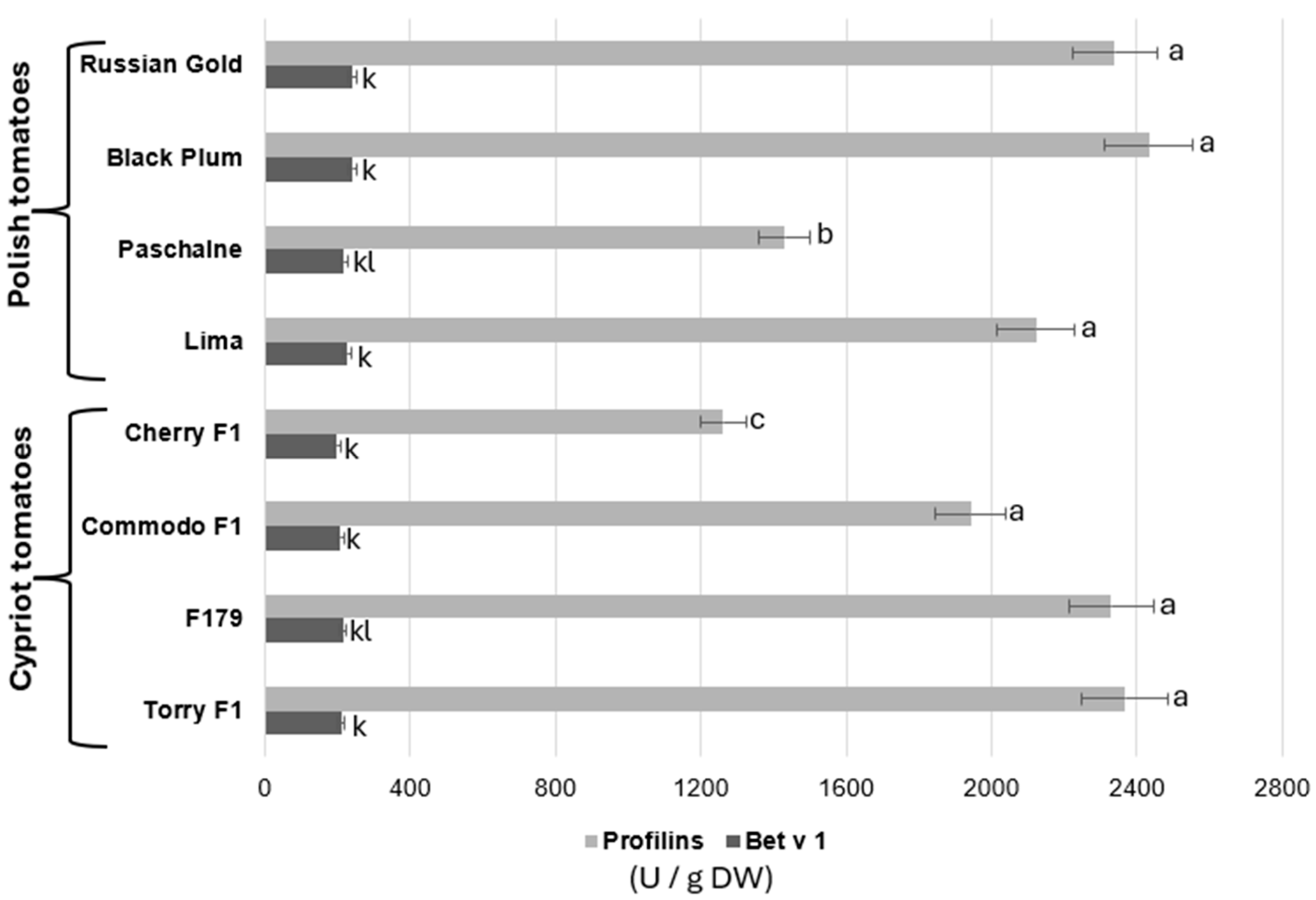
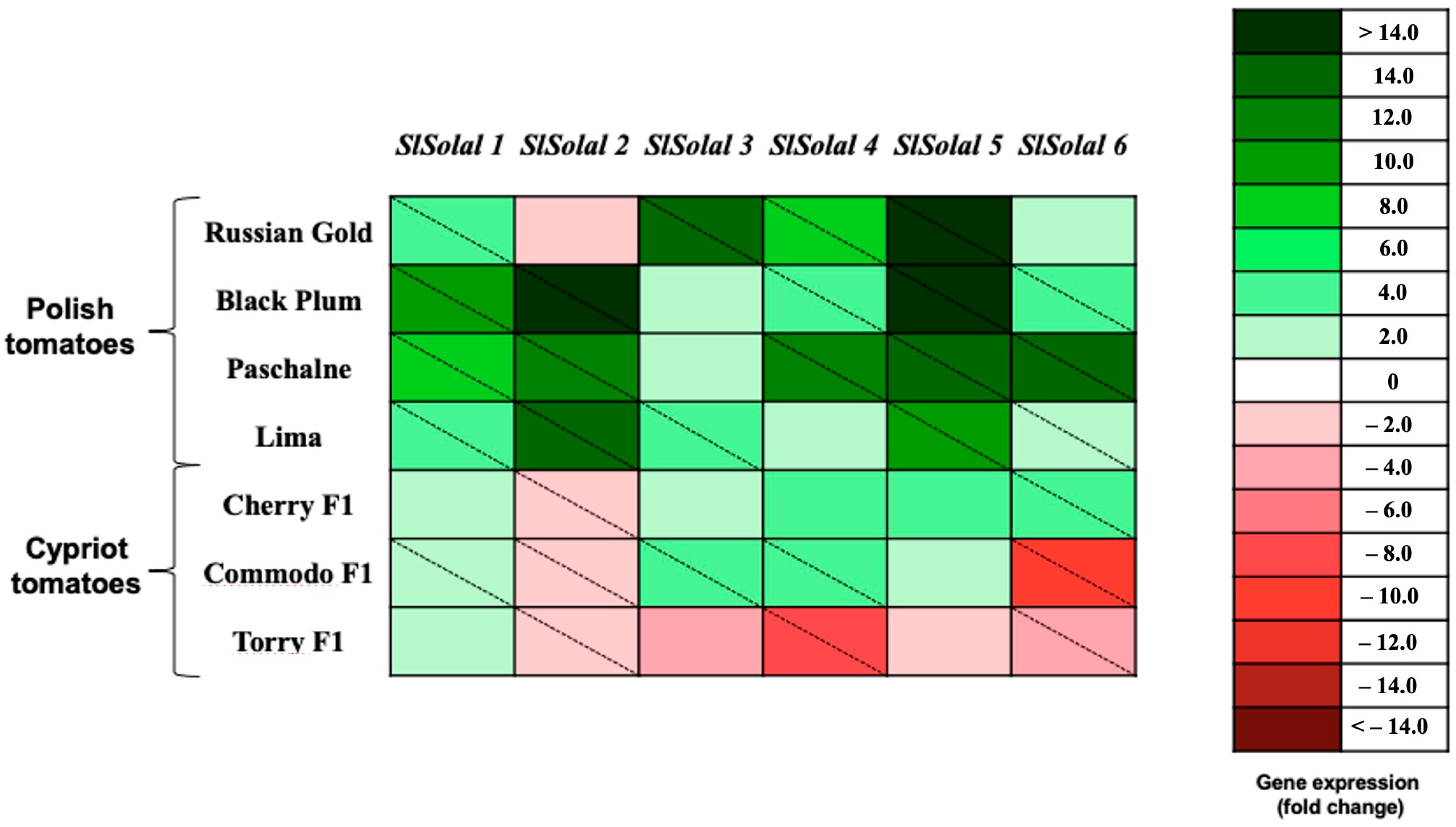
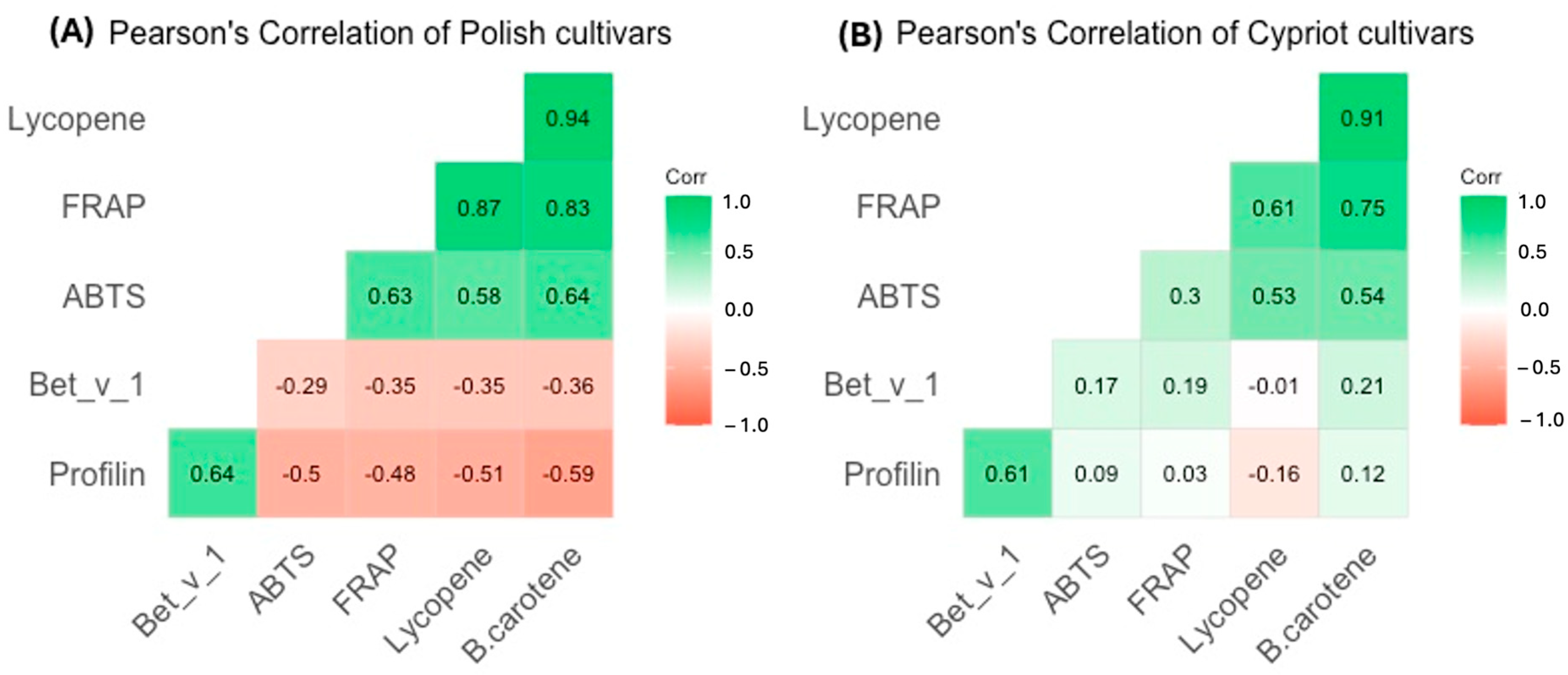
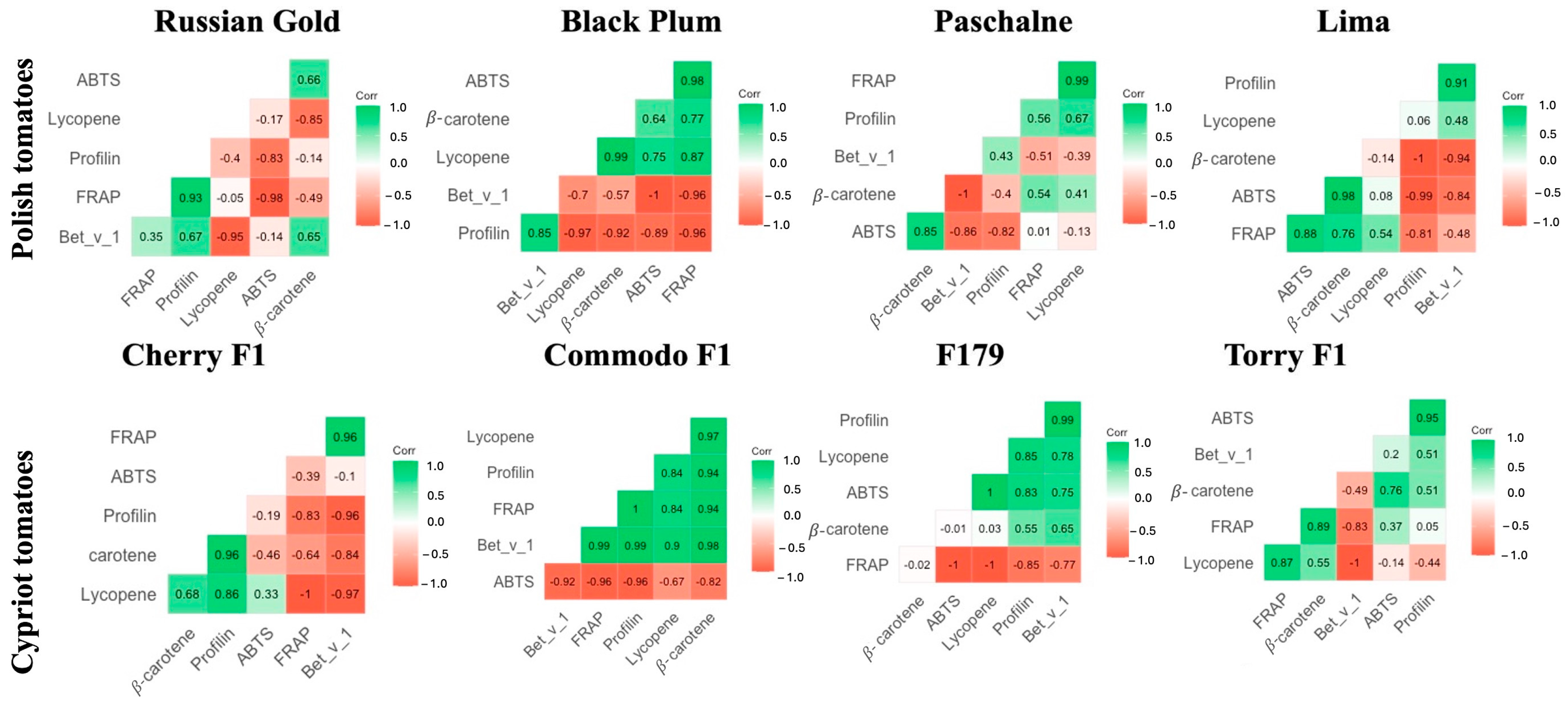
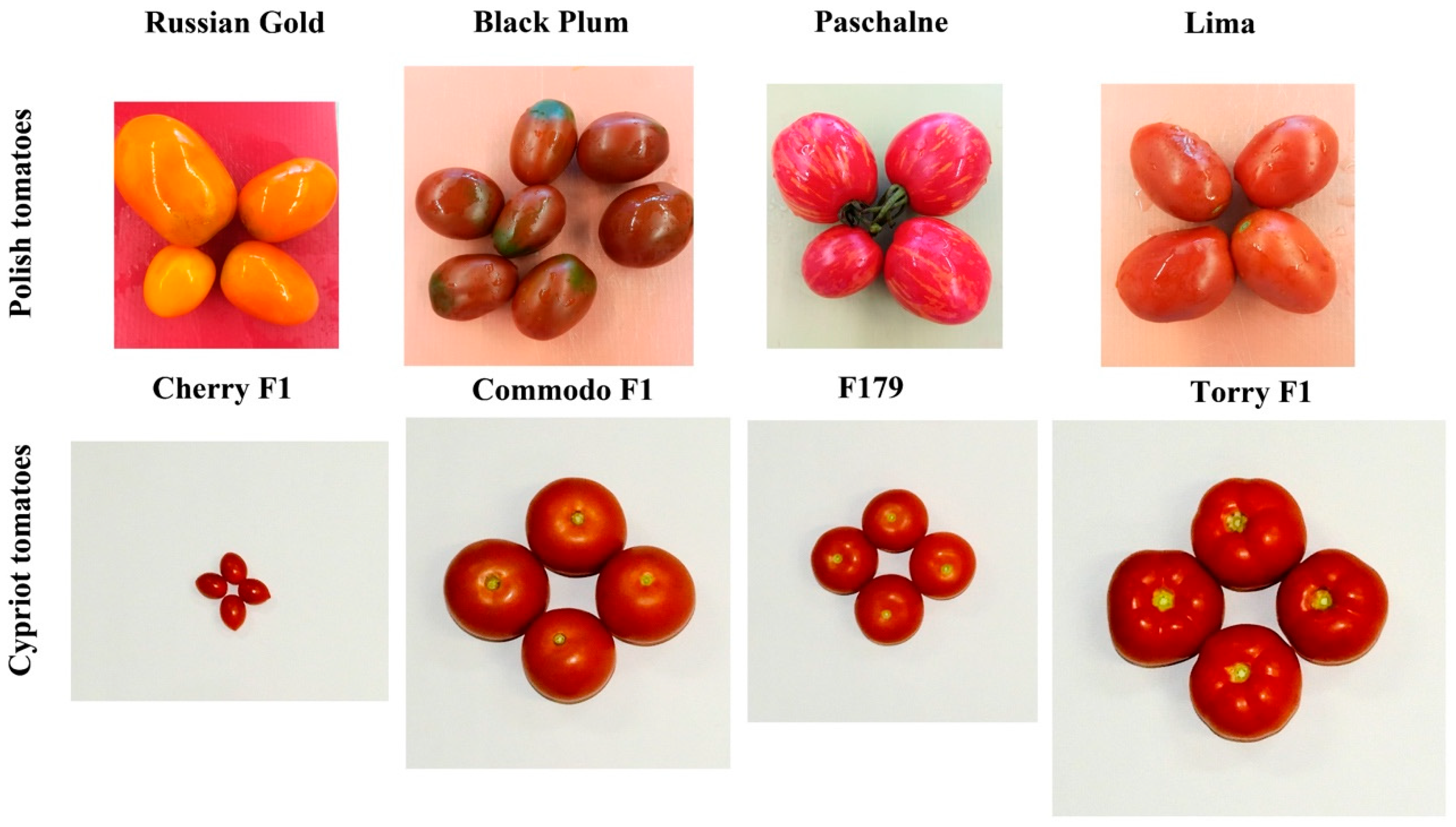
| Tomato Cultivars | TA (g 100 g−1 DW) | |
|---|---|---|
| Polish | Russian Gold | 0.039 ± 0.001 d |
| Black Plum | 0.057 ± 0.001 c | |
| Paschalne | 0.067 ± 0.002 b | |
| Lima | 0.087 ± 0.001 a | |
| Cypriot | Cherry F1 | 0.013 ± 0.001 f |
| Commodo F1 | 0.018 ± 0.001 e | |
| F179 | 0.055 ± 0.001 c | |
| Torry F1 | 0.008 ± 0.001 g | |
Disclaimer/Publisher’s Note: The statements, opinions and data contained in all publications are solely those of the individual author(s) and contributor(s) and not of MDPI and/or the editor(s). MDPI and/or the editor(s) disclaim responsibility for any injury to people or property resulting from any ideas, methods, instructions or products referred to in the content. |
© 2025 by the authors. Licensee MDPI, Basel, Switzerland. This article is an open access article distributed under the terms and conditions of the Creative Commons Attribution (CC BY) license (https://creativecommons.org/licenses/by/4.0/).
Share and Cite
Włodarczyk, K.; Georgiadou, E.C.; Majak, I.; Smolińska, B.; Fotopoulos, V. Suppressed Expression of Allergenic Transcripts in Different Tomato Cultivars Are Linked with Increased Antioxidant Capacity. Int. J. Mol. Sci. 2025, 26, 9446. https://doi.org/10.3390/ijms26199446
Włodarczyk K, Georgiadou EC, Majak I, Smolińska B, Fotopoulos V. Suppressed Expression of Allergenic Transcripts in Different Tomato Cultivars Are Linked with Increased Antioxidant Capacity. International Journal of Molecular Sciences. 2025; 26(19):9446. https://doi.org/10.3390/ijms26199446
Chicago/Turabian StyleWłodarczyk, Katarzyna, Egli C. Georgiadou, Iwona Majak, Beata Smolińska, and Vasileios Fotopoulos. 2025. "Suppressed Expression of Allergenic Transcripts in Different Tomato Cultivars Are Linked with Increased Antioxidant Capacity" International Journal of Molecular Sciences 26, no. 19: 9446. https://doi.org/10.3390/ijms26199446
APA StyleWłodarczyk, K., Georgiadou, E. C., Majak, I., Smolińska, B., & Fotopoulos, V. (2025). Suppressed Expression of Allergenic Transcripts in Different Tomato Cultivars Are Linked with Increased Antioxidant Capacity. International Journal of Molecular Sciences, 26(19), 9446. https://doi.org/10.3390/ijms26199446










